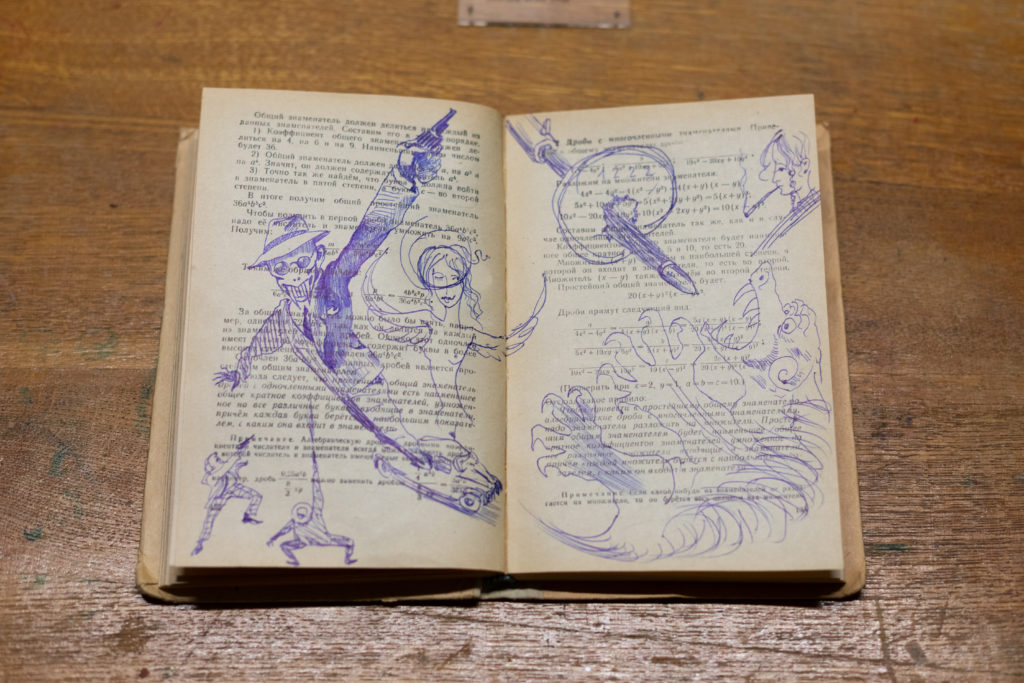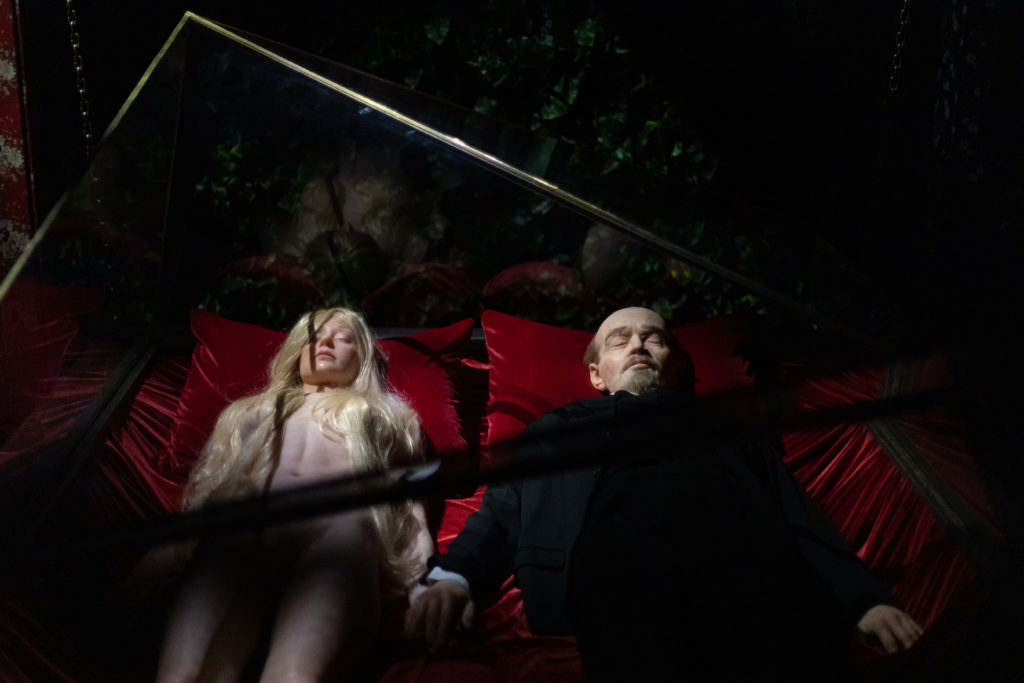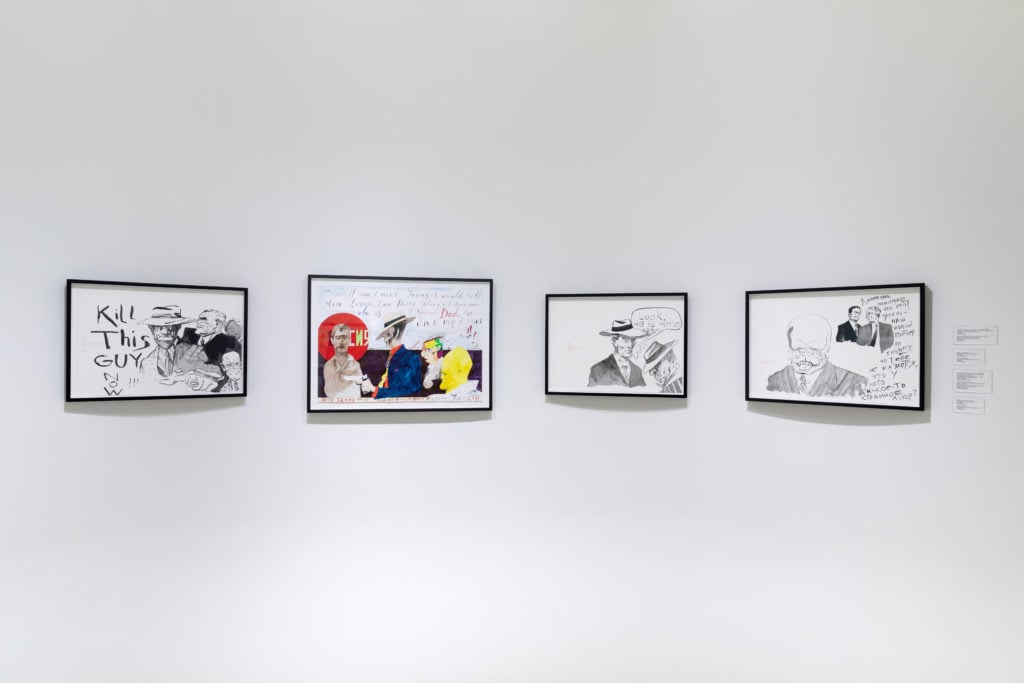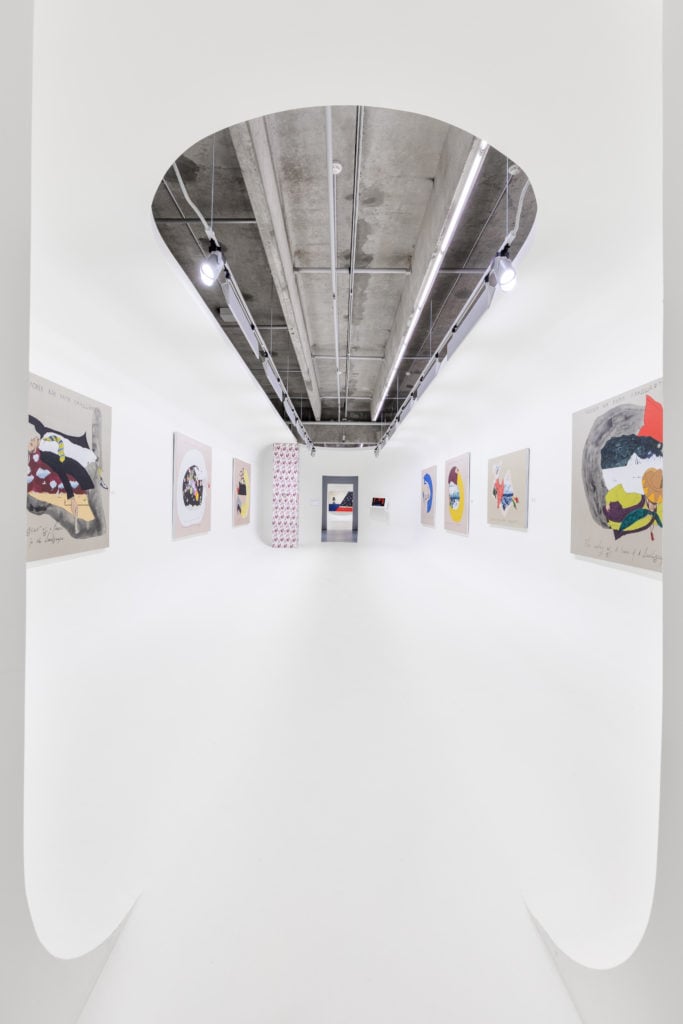On View
Moscow Conceptualist Pavel Pepperstein on Why Some of His Best Art Was Made When He Was a Child—or on Acid
The Russian art star's retrospective is on view at Garage Museum of Contemporary Art in Moscow.

The Russian art star's retrospective is on view at Garage Museum of Contemporary Art in Moscow.

Rachel Corbett

In Russia, Pavel Pepperstein is one of the best-known artists working today. But in the West, his name doesn’t really register, in part because it’s hard for outsiders to understand the context of his work, which has been shaped by Soviet and post-Soviet history.
Pepperstein is a leading member of the younger generation of Moscow Conceptualists, a Soviet avant-garde movement pioneered in the 1970s by artists including Ilya Kabakov, Andrei Monastyrski, Komar and Melamid, and Pepperstein’s father, Viktor Pivovarov. His work also recalls the graphic art scene that blossomed under Soviet rule, when artists often made a living as illustrators (Pepperstein’s mother, Irina Pivovarov, for example, illustrated children’s books.)
But although he is firmly grounded in Russian political history and the Moscow Conceptualist movement, Pepperstein’s work utterly defies Western stereotypes of stoic Soviet aesthetics. Instead of “emptiness”—a key concern of the earlier Moscow Conceptualists—his work is often psychedelic and fantastical, filled with LSD-fueled visions and graphic narratives that transform war crimes into fairy tales. Pepperstein is also a rapper.
On the occasion of his irreverent new retrospective at Moscow’s Garage Museum of Contemporary Art, “Pavel Pepperstein: The Human as a Frame for the Landscape” (through June 2), we spoke to the artist about the ’80s psychedelic scene in Russia, the current state of Moscow Conceptualism, and whether he might be his country’s answer to Raymond Pettibon.
When you were in your twenties you started experimenting with LSD and the visions you had while on the drug began to influence your work. What was the Moscow psychedelic scene like then, in the late 1980s and early ‘90s? Was this common among the artists you knew?
I took LSD for the first time in 1988 and it was a gift from Timothy Leary. My friend Afrika, an artist from St. Petersburg, went to America and met Leary, who gave him three capsules. He said: “This is for you and two more people. You take this and you’ll start a psychedelic revolution in the USSR.” So [Afrika] came back to Moscow and we and another friend met in a significant place, the studio of Ilya Kabakov, who was not there anymore because he was already in Europe. I had the key and so we took the three capsules there. It was a great trip; it lasted three days. We went to the Red Square where we had this feeling that it’s all going to be finished—the Soviet world was close to the end. It was very emotional because we understood ourselves as anti-Soviet, but at this point we understood we were actually deeply Soviet people and we loved our world and we were sad that it was going to end. I remember standing at night in the Red Square on LSD, watching the red flag over the Kremlin on the surface of a black sky and I was saying goodbye. I was in deep love with that red flag in that moment.
The drugs shaped the art you made at the time, but did they also have an effect on your understanding of the purpose of art more broadly?
Absolutely. [With LSD], you get constellations of ideas. You see the connections between things and certain other sides: the back side, the backstage. The spiritual backstage. Then afterward you can use these ideas or they use you. And it’s not only LSD. There are also other things, like ketamine.

A Pavel Pepperstein drawing in “The Human as a Frame for the Landscape,” Garage Museum of Contemporary Art, Moscow, 2019. Photo: Ivan Erofeev © Garage Museum of Contemporary Art.
There’s so much in the show that relates to childhood, including some of your own childhood drawings from the 1970s. What is it about a young person’s way of seeing that interests you so much?
Of course, it’s about my own childhood, but more than that, it’s about childhood as a possible position, a possible way for art and culture and also a spiritual way. That’s why on the banner outside the museum we used a photo of me at age seven. I think that age seven is the top of life. I remember very well this moment when I was seven. It was summer and I was playing alone in the garden when suddenly I thought: This is the top of my life. The best I can do in this situation is commit suicide, not because I’m unhappy but because I’m maximally happy. I was sure that if I continued to live, it would be not so fantastic anymore. So I was thinking about how to do it and I found some instruments, but it was not so easy. I really didn’t know what to do, so then I just forgot about it.
There’s an installation in this show that recreates Lenin’s tomb, where we see a sculpture of him lying dead next to a nude woman. Then there’s a drawing that shows Hitler sort of floating in space. Why do you pacify these terrible dictators and portray them in sort of harmless ways?
I understood at one point that it’s a little bit naive to speak now about Lenin as a political leader, to connect him to his ideas of Communism. He’s now a mythological hero or a certain spirit, and this spirit is very far from the current political reality.

Pavel Pepperstein’s recreation of Lenin in his tomb in “The Human as a Frame for the Landscape,” Garage Museum of Contemporary Art. Photo: Ivan Erofeev © Garage Museum of Contemporary Art.
Do you often hear yourself compared to the American artist Raymond Pettibon? I see a lot of similarities in your graphic and text works.
Yeah, I love his work. There is something close because of the graphic culture and graphic stories—that’s what we both love, what we both do. The connection between text and images, and text that’s also written in a way that it becomes an ornament itself, part of the drawing. I remember when [German art dealer] Rudolf Zwirner organized a show of our work together in his flat in Cologne in the beginning of the 1990s and for me it was very interesting to see how they mixed drawings of Pettibon’s with mine. It was the first time I saw our works together. Then I met him for the first and last time at Garage last year, when he had an exhibition here, but it was very brief, just saying “hello.” I didn’t know him personally, but the drawings can communicate without us.
Are you still rapping? What is the relationship of your musical activities to your visual work?
Not often, but sometimes. I love to have different identities so I also write literature, poems, and I think rap is one of the very significant forms of poetry that we have in our time. Poetry without music has now almost lost its position in culture entirely, but nevertheless poetry is still important; it is just back together with music again like it was in ancient times. That’s why I think almost every poet is a rapper.
Rap culture has its own legends and when you are playing with it of course you play with all its images of the cool man who is tough. For me it’s a pure game. For example, when I took part in the Venice Biennale in 2009, I wrote a big rap for the Russian pavilion about Modern art. It was very anti-contemporary art and it’s done in a protest style: “Biennial in Venice, Documenta in Kassel, when will people smash these shitty glass castles!” And so on.

Pavel Pepperstein, installation view of “The Human as a Frame for the Landscape,” Garage Museum of Contemporary Art, Moscow, 2019. Photo: Ivan Erofeev © Garage Museum of Contemporary Art.
I like that you rhyme “Kassel” with “castle.” Do you have any performances coming up?
Not long ago I created a new genre of rap battle because I had had enough of the competitive spirit. Rappers try to pretend they’re cool and their opponent is not cool enough, so I invented the opposite: a complimentary battle where the rapper has to glorify others and put down himself. We tried this at Garage, which was the first experiment with this style, a rap battle in the old Chinese style where you say, “you are so good.” It was quite an interesting experiment, not perfect because both of us, me and a rapper from St. Petersburg, drank too much. But we’ll do that again.
Would you say that Moscow Conceptualism is still a movement today? How has it evolved?
Yes, but it’s very hard to understand what it’s like now. It’s a part of museums, part of history. On the other hand, people are still alive. Some of them live here, some of them live abroad, but I think it’s still going on. It’s something that is more than just art. It’s also a way of life. Today we can speak about Conceptualism as a lifestyle—how we spend time and interpret things.
What does the lifestyle look like?
For example, some people I know travel, and instead of making their collages of photos about their travels on Instagram, they produce old-fashioned albums in the style of Moscow Conceptualism, showing the connections they find, understanding their own lives and experiences from this point of view. It’s like playing a game of the senses. In this game you take global symbols, things that belong to humankind, and mix them with very personal things. It’s all the time mixing the micro level with the macro level, and you get this special mystical effect where you can understand big things through the little things and little things through the big things. It’s not so easy to explain.

Pavel Pepperstein, installation view of “The Human as a Frame for the Landscape,” Garage Museum of Contemporary Art. Photo: Ivan Erofeev © Garage Museum of Contemporary Art.
The exhibition design for this show at Garage makes it feel as though you’re walking through a spaceship, and feels indicative of the recent revival of Russian cosmism. What inspired you to shape a retrospective of your work in this way?
It’s actually from several movies. It’s [Stanley] Kubrick’s 2001: A Space Odyssey, it’s also [Andrei] Tarkovsky’s Solaris. Kubrick, I think, was a pioneer in the idea that knowledge of the earth could come from a distance. Tarkovsky developed this idea into one where you can also understand your own past, your own soul with the same distance—space distance. So in Solaris, people in the orbital station are standing in front of an unknown planet, Solaris, but Solaris knows everything about them. it can reconstruct fragments of their past: people with whom they were in love, fragments of landscapes. So the structure in this show is about the past and childhood, but these fragments of the past are fragments of different periods. It’s using a space context for distance.